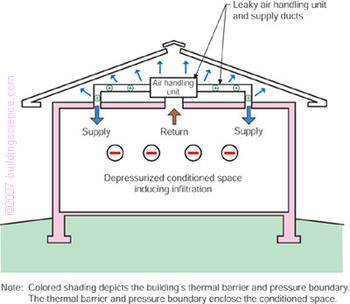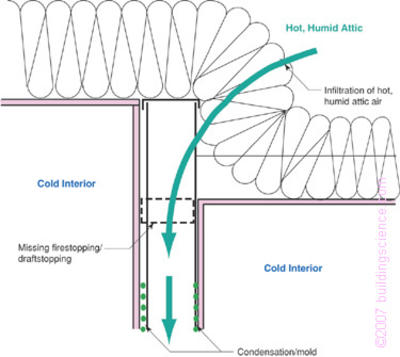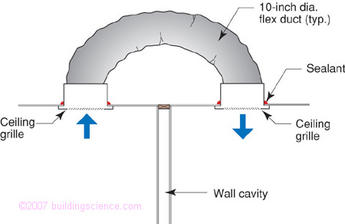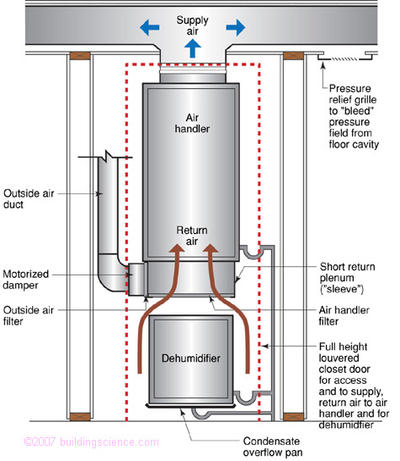Adding outdoor air in hot humid climates causes moisture problems right? Sometimes. It depends on the condition of the house before you start to add outdoor air. Contrary to popular belief, most houses in hot, humid climates are over ventilated due to duct leakage and induced air change from internal air pressure effects due to unbalanced air flow and door closure.
In most houses when HVAC systems are operating, air change rates of between 0.5 and 1.0 ach are common. Between 150 cfm and 200 cfm of outdoor air is typically introduced in this manner when systems are operating. When HVAC systems are not operating, air change rates of between 0.1 ach and 0.2 ach are common due to stack forces and wind.
ASHRAE Standard 62.2 recommends adding approximately 40 to 50 cfm of outdoor air. If duct leakage and pressure effects are addressed, no additional latent load is added during full load periods. The uncontrolled air change is dropped to near zero and controlled air change is added in its place. The resultant latent load is typically similar or lower than standard practice – again under full load. However, if outdoor air is added to a standard house with duct leakage and internal pressure effects, moisture problems are almost assured - duct leakage and internal air pressure effects must be addressed.
Even if duct leakage and internal pressure effects are addressed, the latent loads introduced by ventilation air during part load periods are significant and must be addressed. This can only be done with supplemental dehumidification – or ASHRAE Standard 62.2 flow rates should be reduced.
Introduction
Ventilation is an obvious latent load in hot humid climates. What is less obvious is that there are two components to ventilation: the controlled component and the uncontrolled component. The controlled component is of course the outdoor air the designer adds to the building via a controlled ventilation system. The uncontrolled component is defined here as air change created by wind effects, stack effects and the pressure effects from the operation of the HVAC system.
The uncontrolled component in most houses is larger than commonly assumed and typically larger than the desired controlled component. Adding an additional controlled component to this large uncontrolled component would only make an already bad situation worse.
ASHRAE Standard 62.2 (Ventilation for Acceptable Indoor Air Quality in Low-Rise Residential Buildings) recommends the following ventilation rate:
- 7.5 cfm/person + 0.01 cfm/ft2 of conditioned floor area
- Occupancy is defined as the # of bedrooms + 1
For a common single family detached house (3 bedrooms; 2,000 ft2) this works out to 50 cfm of outdoor air. Restated, based on typical house volumes (ceiling heights at 8 ft), this is between 0.2 and 0.3 air changes per hour.
The uncontrolled component is dominated by pressure effects created by the operation of the HVAC system. Wind effects and stack effects acting on residential enclosures in hot humid climates are low enough to be almost neglected. This is reflected in ASHRAE Standard 136 (A Method of Determining Air Change in Detached Dwellings) and the tabulated values for W (the weather factor) and an appreciation of residential construction. Most residential enclosures in hot humid climates are low rise (below two storys – often one story – therefore only a small stack potential exists even if an appreciable temperature difference is present) and clad with stucco (a tight cladding system that is relatively wind insensitive).
Work done by Tooley, Moyer, Cummings and many others in the late 1980’s and early 1990’s showed that the operation of the HVAC system in homes constructed in hot humid climates yielded air change rates of between 0.5 and 1.0 when the systems were operating. When HVAC systems were not operating the same research work showed air change rates of 0.1 to 0.2 ach.
Duty cycles (on time) often range between 30 and 70 percent. Assuming a 33 percent duty cycle, the HVAC system induced air change is equal to a continuous ventilation rate of between 50 cfm and 100 cfm.
At the time of the work by Tooley, Moyer, Cummings, the typical house envelope leakage characteristics ranged between 2,000 and 3,000 cfm at 50 Pa. In other words, the building envelopes were fairly “leaky.” One obvious, but often overlooked, truth is that air change does not occur without an air pressure difference – even in a “leaky” building enclosure. In the humid south, since stack effects and average wind speeds acting on low rise residential enclosures are small, air change due to these effects is low, and almost independent of envelope leakage area.
During the past decade, residential building envelope leakage areas have decreased due to more effective draftstopping. This has resulted in an unintended consequence – air pressure differences within houses and between houses and the exterior have increased when HVAC systems are operating. Although the airtightness of the building envelope has increased, the expected air change reduction has not occurred due to the induced air pressure effects. Houses with leaky ductwork and unbalanced air flows continue to have high air change rates despite improvements in building envelope construction.
Pressure Effects
HVAC system induced air change occurs two ways: leaky ductwork and air handlers located outside of the building pressure boundary (Figure 1) and unbalanced air flows due to door closure and inadequate return flow (Figure 2). A subset of the first type of air change also occurs due to air pressure effects within building cavities (Figure 3). This type of induced infiltration results in serious interstitial moisture problems, but does not always constitute a significant interior latent load.
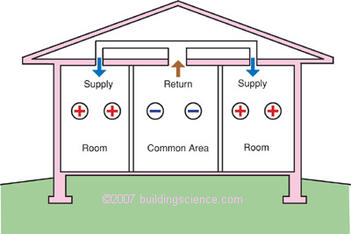
Figure 2: Pressure Effect Due to Unbalanced Air Flows
Figure 3: Air Pressure Effects within Building Cavities
Addressing the uncontrolled HVAC system induced air change requires tight ductwork, sealed air handlers, and balancing the flow between rooms. With tight ductwork, sealed air handlers and balanced air flow, uncontrolled air change can be reduced to near zero.
Ductwork and air handler leakage can be addressed using many techniques that will not be addressed here (except to say that standard duct tape is not one of them). Leakage values of approximately 5 percent (as tested by pressurization at 25 Pa) of total flow or less appear to result in negligible air change when HVAC systems are operating and return system flows are balanced (Lstiburek & Rudd). Numerous federal, state and utility construction programs have promoted duct system and air handler leakage performance specifications in the 5 percent range – a range of duct leakage that appears to be justified based on the field experience to date.
Pressurization effects due to door closure can cause significant air change and comfort problems. Bedroom pressurization relative to hallway/common areas of 10 to 20 Pa is common with single return systems (Tooley & Moyer). These effects can be mitigated using transfer grilles (Figure 4) or jump ducts (Figure 5).
The New Moisture Balance
If the uncontrolled air change is reduced to near zero and replaced with a continuous flow roughly equal to the uncontrolled air change, it can be argued that the net moisture balance should remain unaffected. Adding controlled ventilation does not increase latent loads under this condition.
However, this is only true during the time of year when HVAC systems regularly operate. During the spring and fall months – during the “part load” seasons - HVAC systems do not regularly operate. Air change drops to between 0.1 and 0.2 ach. The typical house has a very low latent load due to air change during this time. This is fortunate since there is also almost no provision for moisture removal during this time by the HVAC system. Adding controlled ventilation to this condition does constitute a significant increase in the latent load. In fact, the load during this time is almost completely latent because the outdoor dry-bulb temperature is very near to the indoor dry-bulb temperature – and this latent load is effectively doubled in the typical house by adding a ventilation rate of 0.15 and 0.2 ach (the typical ASHRAE Standard 62.2 rate).
Gatley notes that the process of air conditioning consists of approximately 70 percent sensible cooling in the form of temperature reduction accompanied by approximately 30 percent latent cooling in the form of water vapor removal. According to Gatley, at partial load operating conditions which occur for a majority of system operating hours many dwellings in hot humid climates require higher ratios of latent cooling – 40 to 50 percent. This is not possible with standard residential air conditioning equipment.
The latent load problem under part load conditions during the spring and the fall in humid climates is progressively becoming more serious as the typical residential building envelope and its mechanical equipment evolve. The use of high performance window systems (spectrally selective windows – high visible light transmittance, low solar heat gain coefficient) is significantly increasing the time period of part load conditions during the year. This is coupled with equipment with higher SEER and EER ratings with no latent load control. And as a final insult to the house and its occupants, the equipment is typically oversized (on the order of 150 percent or more of total load). Adding controlled ventilation with untreated outdoor air to a house under these conditions almost assures problems – even with tight ductwork, sealed air handlers and balanced air flows.
Gatley, citing work done by The Trane Company, shows the effect of oversizing. Systems oversized by 20 percent achieve latent heat removal of approximately 15 percent of the total cooling load under the assumed part load conditions. Whereas, correctly sized systems achieve moisture removal of up to approximately 30 percent under part load conditions. The same work shows that in correctly sized systems with variable speed fans with constant speed refrigeration compressors achieve 35 percent moisture removal under part load conditions. With variable refrigeration compression this moisture removal is even greater.
Sizing of equipment will not be addressed here except to note that it is a major residential HVAC industry problem. Even with correctly sized standard HVAC systems, the part load problem associated with the latent load remains – albeit not to the same extent.
The author’s experience with newly constructed houses in hot humid climates has led him to conclude that supplemental dehumidification during part load periods is necessary – especially in houses with controlled ventilation.
Three general approaches to supplemental dehumidification in residences are recommended: stand-alone dehumidifiers (Figure 6); enhanced air conditioning systems (variable speed blowers and compressors); and ventilating dehumidifiers. Each approach has advantages and disadvantages.
Air handler located and accessed within interior conditioned space.
- Dehumidifier and condensate overflow pan supported by metal stand.
- Dehumidifier drain plumbed to air handler condensate system.
- Outside air provided to return side of system with motorized damper control.
- Flow controller for outside air should not allow air handler to run with motorized damper open for 15 minutes after cooling is de-energized to prevent re-evaporation of condensate from coils and drain pan.
- Outside air is controlled by a motorized damper. Closing the outside air damper during unoccupied periods will allow the flow controller to periodically mix the interior air without bringing in outside air helping the dehumidifier control interior RH – humid air is brought to the dehumidifier. The cooling function of the A/C can also be shut down during this time (i.e. A/C on blower only operation).
- Pressure relief grille provided to “bleed” accidental/incidental pressure field created by duct leakage.
The use of a stand-alone dehumidifier plumbed/drained to a condensate drain has the advantage of low cost (adds approximately $300 to the typical house). The disadvantage is the heat generated by the dehumidifier and it’s effect on comfort. Additionally, operating costs are the highest of the three general approaches. However, it is a simple to implement solution and typically compensates for oversizing of equipment.
The use of enhanced air conditioning systems has the advantage of not having to install a separate piece of equipment. The disadvantage is a substantial increase in cost (adds approximately $1,000 or more to the typical house). Additionally, equipment sizing is critical. However, implementation is the easiest of the three systems and costs are likely to drop the most as these systems become “commodity items” as opposed to “special order.”
The use of ventilating dehumidifiers has the advantage of the lowest operating cost (since these dehumidifiers have been optimized for humidity removal). The chief disadvantage is their current cost (adds approximately $2,000 to the typical house).
Conclusions
In order to provide controlled ventilation in new houses constructed in hot humid climates without creating latent load problems it is necessary to take the following measures:
- Install tight ductwork and air handlers
- Balance interior air flows
- Size equipment correctly
- Provide supplemental dehumidification
References
ASHRAE Standard 136-1993 (RA 2001); A Method of Determining Air Change Rates in Detached Dwellings, ASHRAE, Atlanta, GA, 2001.
ASHRAE Standard 62.2P; Ventilation for Acceptable Indoor Air Quality in Low-Rise Residential Buildings, ASHRAE, Atlanta, GA, 2002.
Cummings, J.B. and Tooley, J.J.; "Infiltration Rates and Pressure Differences in Florida Homes Caused by Closed Interior Doors When the Central Air Handler is On," Passive Solar Conference, Cambridge, MA, 1988.
Cummings, J.B. and Tooley, J.J.; “Infiltration and Pressure Differences Induced by Forced Air Systems in Florida Residences,” ASHRAE Transactions, June, 1989.
Gatley, D.P.; “Energy Efficient Dehumidification Technology,” Workshop Proceedings: Bugs, Mold & Rot II, Building Environment and Thermal Envelope Council, Washington, DC, November 16-17, 1993.
Lstiburek, J.W.; “Humidity Control in the Humid South,” Workshop Proceedings: Bugs, Mold & Rot II, Building Environment and Thermal Envelope Council, Washington, DC, November 16-17, 1993.
Lstiburek, J.W. and Rudd, A.; Controlled Ventilation in Building America Houses, Building Science Corporation, Westford, MA, 2002.
Tooley, J.J. and Moyer, N.A.; Mechanical Air Distribution and Interacting Relationships, Florida Home Energy Reviews of Orlando, Orlando, Florida, February, 1988.

